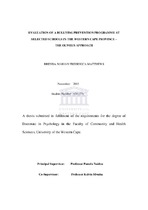| dc.description.abstract | The study aimed to pilot-test the effectiveness of the Olweus Bullying Prevention
Intervention Programme (OBPP) at two selected primary schools in the Western Cape; and to compare the differences in reported incidents of bullying between the control schools (CSs) and intervention schools (ISs), after the OBPP intervention. On the basis of these aims, the stated objectives were to measure bullying behaviour for pre-test and post-test comparisons with the CSs after the implementation of the OBPP at the ISs; and to investigate the effectiveness of the OBPP by comparing the ISs and CSs for programme targets. Three main hypotheses were formulated and tested, including: (1) There is no statistically significant difference in the mean rank of learners’ exposure to various types of bullying, characteristics (grade level and gender) of the perpetrator, locations of where the bullying occurred, disclosure of the bullying incident, participants’ and peers’ feelings of support, reactions and attitudes when experiencing or witnessing a bullying incident, parents’ and teachers’ reactions and efforts to support and protect victims and participants’ reports of satisfactory schooling environments at
the ISs and CSs before and after intervention; (2) There is no statistically significant difference in mean rank of learners’ exposure to various types of bullying, characteristics (grade level and gender) of the perpetrator, locations of where the bullying occurred , disclosure of the bullying incident, participants’ and peers’ feelings of support, reactions and attitudes when experiencing or witnessing a bullying incident, parents’ and teachers’ reactions and efforts to support and protect victims and participants’ reports of satisfactory schooling environments between females’ and males’ reports before and after intervention; (3)There is no statistically significant difference in mean rank of learners’ exposure to various types of bullying, characteristics (grade level and gender) of the perpetrator, locations of where the bullying occurred , disclosure of the bullying incident, participants’ and peers’ feelings of support, reactions and attitudes when experiencing or witnessing a bullying incident, parents’ and teachers’ reactions and efforts to support and protect victims and participants’ reports of satisfactory schooling environments between females’ and males’ at the ISs and CSs before and after intervention. In order to provide the relevant theoretical orientations to the study, the Olweus Approach, served as a framework for investigating the prevalence and extent of bullying in the selected schools, while Bronfenbrenner’s Ecological theoretical framework was used to inform the study. In order to reach these objectives, a quantitative method using a questionnaire to collect data and a quasi-experimental design with intervention (ISs) and control (CSs) groups was used. The following are the main findings in terms of tested hypotheses: Firstly, there is a positive statistically significant difference concerning the CSs variables that include peer support toward bullying (school 2 and 4) where females represented higher mean ranks than males at school 2 and males were represented by higher mean ranks compared to females for school 4. Furthermore, for the variables peer attitudes toward bullying (school 4) and reported satisfactory schooling environments (school 4), more females than males attested for both. This suggests a favourable effect without the intervention. Furthermore, there is a statistically significant difference concerning the ISs variables that include characteristics (grade level and gender) of the perpetrator (school 1), disclosure of the bullying incident (school 1), peer reaction and attitudes toward bullying (school 1), parents’ and teachers’ reactions and efforts to support and protect victims against bullying (school 1 & 3), class teacher efforts to support and protect victims of bullying (school 1) as well as reported satisfactory schooling environments
( school 1). Secondly, it is noteworthy that for all the variables that presented statistically significant differences between females and males at baseline and follow
up for the ISs – on average more females compared to males attested to this. Finally, statistically significant differences in terms of overall positive improvements i.e. N=200 that reported been bullied at baseline, was highlighted at only one of the ISs (school 1). Variables in this regard, included exposure to various types of bullying, characteristics (grade and level) of the perpetrator, disclosure of the bullying and reports of having a satisfactory schooling environment and noteworthy is that more males than females attested to be exposed to various types of bullying. These findings confirmed that the implementation of the OBPP has shown to be an effective programme at instilling an anti-bullying culture in terms of the named variables. The study therefore recommends, among others, that schools address existing bullying behaviour and prevent further bullying by building and enhancing existing connections between itself and the community which it serves; that the staff as a whole sets the standards of advocating an anti-bullying culture; and that teacher training colleges and universities offer the guidelines of the OBPP as a part of the students’ curriculum requirements. | en_US |

